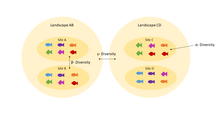Biodiversity/Introduction

Definition Biodiversity
[edit | edit source]Biodiversity, a portmanteau of "bio" (life) and "diversity", generally refers to the variety and variability of life. According to the United Nations Environment Programme (UNEP), biodiversity typically measures variation at the genetic, the species, and the ecosystem level.[1] Biologists most often define biodiversity as the "totality of genes, species and ecosystems of a region".[2][3] That includes:
- taxonomic diversity (usually measured at the species diversity level)
- ecological diversity often viewed from the perspective of ecosystem diversity
- morphological diversity which stems from genetic diversity and molecular diversity[4]
- functional diversity which is a measure of the number of functionally disparate species within a population (e.g. different feeding mechanism, different motility, predator vs prey, etc.)[5]
Diversity index
[edit | edit source]A diversity index is a quantitative measure that reflects how many different types (such as species) there are in a dataset (a community), and simultaneously takes into account how evenly the basic entities (such as individuals) are distributed among those types. The general equation of diversity is often written in the form[6][7]
and the term inside the parentheses is called the basic sum. Some popular diversity indices correspond to the basic sum as calculated with different values of q.[7]
Richness
[edit | edit source]Richness R simply quantifies how many different types the dataset of interest contains. For example, species richness (usually noted S) of a dataset is the number of different species in the corresponding species list. Richness is a simple measure, so it has been a popular diversity index in ecology, where abundance data are often not available for the datasets of interest. Because richness does not take the abundances of the types into account, it is not the same thing as diversity, which does take abundances into account. However, if true diversity is calculated with q = 0, the effective number of types (0D) equals the actual number of types (R).[7][8]
Shannon index
[edit | edit source]The Shannon entropy quantifies the uncertainty (entropy or degree of surprise) associated with this prediction. It is most often calculated as follows:
where pi is the proportion of characters belonging to the ith type of letter in the string of interest. In ecology, pi is often the proportion of individuals belonging to the ith species in the dataset of interest. Then, the Shannon entropy quantifies the uncertainty in predicting the species identity of an individual that is taken at random from the dataset.
Simpson index
[edit | edit source]The measure equals the probability that two entities taken at random from the dataset of interest represent the same type.[9] It equals:
- ,
where R is richness (the total number of types in the dataset). This equation is also equal to the weighted arithmetic mean of the proportional abundances pi of the types of interest, with the proportional abundances themselves being used as the weights.[6] Proportional abundances are by definition constrained to values between zero and unity, but it is a weighted arithmetic mean, hence λ ≥ 1/R, which is reached when all types are equally abundant.
Alpha, beta and gamma diversity
[edit | edit source]
In ecology, alpha diversity (α-diversity) is the mean species diversity in sites or habitats at a local scale. The term was introduced by R. H. Whittaker[10][11] together with the terms beta diversity (β-diversity) and gamma diversity (γ-diversity). Whittaker's idea was that the total species diversity in a landscape (gamma diversity) is determined by two different things, the mean species diversity in sites or habitats at a more local scale (alpha diversity) and the differentiation among those habitats (beta diversity).
- Alpha-Diversity :
- Beta-Diversity :β = γ/α
- Gamma-Diversity :
Exercises
[edit | edit source]
Page information
[edit | edit source]- Page content is based on: https://en.wikipedia.org/wiki/Biodiversity, https://en.wikipedia.org/wiki/Diversity_index, https://en.wikipedia.org/wiki/Diversity_index, https://en.wikipedia.org/wiki/Alpha_diversity, https://en.wikipedia.org/wiki/Beta_diversity, https://en.wikipedia.org/wiki/Gamma_diversity
References
[edit | edit source]- ↑ "What is biodiversity?" (PDF). United Nations Environment Programme, World Conservation Monitoring Centre.
- ↑ Tor-Björn Larsson (2001). Biodiversity evaluation tools for European forests. Wiley-Blackwell. p. 178. ISBN 978-87-16-16434-6. https://books.google.com/books?id=zeTU8QauENcC&pg=PA178. Retrieved 28 June 2011.
- ↑ Davis. Intro To Env Engg (Sie), 4E. McGraw-Hill Education (India) Pvt Ltd. p. 4. ISBN 978-0-07-067117-1. https://books.google.com/books?id=n0FvYeoHtAIC&pg=PA40. Retrieved 28 June 2011.
- ↑ Campbell, AK (2003). "Save those molecules: molecular biodiversity and life". Journal of Applied Ecology 40 (2): 193–203. doi:10.1046/j.1365-2664.2003.00803.x.
- ↑ Lefcheck, Jon. "What is functional diversity, and why do we care?". sample(ECOLOGY). Retrieved 2015-12-22.
- ↑ 6.0 6.1 Hill, M. O. (1973). "Diversity and evenness: a unifying notation and its consequences". Ecology 54: 427–432. doi:10.2307/1934352.
- ↑ 7.0 7.1 7.2 Jost, L (2006). "Entropy and diversity". Oikos 113: 363–375. doi:10.1111/j.2006.0030-1299.14714.x.
- ↑ Tuomisto, H (2010). "A consistent terminology for quantifying species diversity? Yes, it does exist". Oecologia 4: 853–860. doi:10.1007/s00442-010-1812-0.
- ↑ Simpson, E. H. (1949). "Measurement of diversity". Nature 163: 688. doi:10.1038/163688a0.
- ↑ Whittaker, R. H. (1960) Vegetation of the Siskiyou Mountains, Oregon and California. Ecological Monographs, 30, 279–338. doi:10.2307/1943563
- ↑ Whittaker, R. H. (1972). Evolution and Measurement of Species Diversity. Taxon, 21, 213-251. doi:10.2307/1218190
- ↑ Biodiversity. (2018, January 7). In Wikipedia, The Free Encyclopedia. Retrieved 17:57, January 10, 2018, from https://en.wikipedia.org/w/index.php?title=Biodiversity&oldid=819113970




![{\displaystyle {}^{q}\!D_{\alpha }={\sqrt[{1-q}]{\sum _{j=1}^{N}w_{j}({}^{q}\!D_{\alpha j})^{1-q}}}}](https://wikimedia.org/api/rest_v1/media/math/render/svg/a8f078ce36f12782b86251fe7c4e6903dfaba5b0)
![{\displaystyle {}^{q}\!D_{\gamma }={1 \over {\sqrt[{q-1}]{\sum _{i=1}^{S}p_{i}p_{i}^{q-1}}}}}](https://wikimedia.org/api/rest_v1/media/math/render/svg/60a6e7de238a6ed207e42f9f12aaee94cad4c6fe)